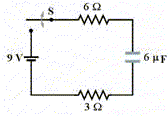The resistance between points a and b in figure 5 is
60 ohms. What is the value of R ?

a 50 ohms
b 10 ohms
c 42 ohms
d 18 ohms
e 0.5 ohms
==============================================
Question 2
In figure (5), all the resistors have a value of 2 Ohms. The
battery is ideal with an emf = 15 V. What is the potential
difference across the resistor R3?

a 1.5 Volts.
b 5.0 Volts.
c 15 Volts.
d 3.0 Volts.
e 2.5 Volts.
==============================================
Question 3
In figure 6: R1 = 2.0 ohms, R2 = 4.0 ohms, R3 = 8.0 ohms,
E1 = 2.0 volts, E2 = 4.0 volts and E3 = 6.0 volts.
What is the rate of energy dissipation in R1 ?

a 0.16 W
b 0.32 W
c 0.24 W
d 0.08 W
e 0.40 W
==============================================
Question 4
What is the power dissipated in 4.0 Ohm resistor in Figure 4.

a 9.0 W.
b 4.3 W.
c 1.2 W.
d 3.0 W.
e 6.0 W.
==============================================
Question 5
A battery is connected across a series combination
of two identical resistors. If the potential difference
across the terminals of the battery is V, and the current
in the battery is I, then:
a the potential difference across each resistor is V
and the current in each resistor is I/2.
b the potential difference across each resistor is V/2
and the current in each resistor is 2I.
c the potential difference across each resistor is V
and the current in each resistor is I.
d the potential difference across each resistor is V/2
and the current in each resistor is I/2.
e the potential difference across each resistor is V/2
and the current in each resistor is I.
==============================================
Question 6
In figure (8), what is the potential difference Va-Vb

a 8 V.
b 10 V.
c 26 V.
d 6 V.
e 2 V.
==============================================
Question 7
In the circuit shown in figure 3, the capacitor was
initially uncharged. At time t = 0, switch S is closed.
If T denotes the time constant, the current through the
3-ohm resistor at t = T/10 is

a 0.90 A.
b 1.5 A.
c 2.5 A.
d zero.
e 3.0 A.
==============================================
Question 8
At t=0, a 2.0*10**(-6) Farad capacitor is connected in series
to a 20-V battery and a 2.0*10**6 Ohm resistor. How long does
it take for the potential difference across the capacitor to
be 12 V?
a 3.7 s.
b 2.8 s.
c 1.2 s.
d 0.6 s.
e 2.0 s.
==============================================
Question 9
In figure 5, the current in the 5.0-ohm resistor is 3.0 A.
What is the potential difference Va - Vb ?

a + 30 V
b + 54 V
c - 30 V
d + 6.0 V
e - 6.0 V
==============================================
Question 10
A portion of a circuit is shown in figure (6), with the
values of the currents given for some branches. What is
the direction and value of the current I?

a Down, 2 A.
b Down, 4 A.
c Up, 6 A.
d Down, 6 A.
e Up, 4 A.
==============================================
Question 11
Calculate the power dissipated in the 6.0-ohm
resistor in figure 6.

a 1.5 W
b 1.7 W
c 2.3 W
d 3.4 W
e 30 W
==============================================
Question 12
The current in the 5.0-ohm resistor in the circuit shown
in figure (7) is:

a 3.0 A.
b 0.67 A.
c 5.0 A.
d 2.4 A.
e 0.42 A.
==============================================
Question 13
For the circuit shown in figure 4, find the potential
difference VA - VB, if I1 = 3.0 A and I3 = 4.0 A.

a - 30 V
b + 32 V
c + 20 V
d - 32 V
e - 20 V
==============================================
Question 14
In figure 3, if R = 10 Ohm find the current in R.

a - 0.2 A.
b - 1.1 A.
c 0.4 A.
d 0.2 A.
e - 0.4 A.
==============================================
Question 15
A certain capacitor, in series with a 720-ohm resistor, is
being charged. At the end of 10 milliseconds, its charge
is 50 % of the maximum charge.
The capacitance is:
a 20 micro-Farad
b 9.6 micro-Farad
c 14 micro-Farad
d 10 micro-Farad
e 7.2 micro-Farad
==============================================
Question 16
In figure 2, a battery of emf of 12-Volt and internal
resistance of r = 3.0 Ohm is connected to a bulb of
resistance R. If the bulb will light at a steady current
of 0.1 A, what should the value of R be?

a 200 Ohm.
b 130 Ohm.
c 40 Ohm.
d 117 Ohm.
e 35 Ohm.
==============================================
Question 17
A resistor R = 30*10**6 Ohm is connected in series with
a capacitor C = 3.0 micro-F and a 21-Volt battery for
long time. The battery was removed, then R and C are
connected in a loop. What is the energy stored in the
capacitor C after one minute?
a 204 micro-J.
b 24 micro-J.
c 47 micro-J.
d 174 micro-J.
e 11 micro-J.
==============================================
Answers
1 c
2 d
3 b
4 a
5 e
6 c
7 a
8 a
9 a
10 d
11 d
12 c
13 e
14 a
15 a
16 d
17 d